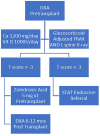Treatment of osteoporosis in the solid organ transplant recipient: an organ-based approach
- PMID: 40529292
- PMCID: PMC12171267
- DOI: 10.1177/20420188251347351
Treatment of osteoporosis in the solid organ transplant recipient: an organ-based approach
Abstract
Bone and mineral disorders are highly prevalent in solid organ transplant recipients. These patients are at high risk for osteoporosis and fragility fractures due to several pre- and post-transplant factors, including end-stage organ disease leading to chronic malnutrition and osteomalacia, as well as chronic immunosuppressive therapy that has direct adverse effects on bone remodeling. Low pre-transplant bone mineral density is associated with an increased risk for fragility fracture post-transplant. Furthermore, there is a precipitous loss of bone density within 6-12 months post-transplant due to a myriad of causal factors. In this review, we will elaborate on the treatment options and challenges in management of osteoporosis in solid organ recipients using vitamin D, calcium, bisphosphonates, denosumab, and osteoanabolic agents. The greatest body of evidence discusses the use of bisphosphonates, with most patients benefiting from early treatment.
Keywords: bisphosphonates; bone loss; fragility fracture; glucocorticoid; heart transplant; kidney transplant; liver transplant; lung transplant; osteoanabolic agents; osteoporosis; osteoporotic fracture; solid organ transplant.
Plain language summary
Review of treatment options for low bone density after solid organ transplant Increased survival in transplant recipients has resulted in the recognition of long-term complications in this population, including osteoporosis and fractures. Due to existing pre-transplant bone disease and post-transplant immunosuppressive therapies, solid organ transplant recipients are at an increased risk for bone loss and fracture. Pre-transplant risk factors should be optimized by addressing secondary etiologies of osteoporosis including vitamin D and calcium insufficiency. Unique bone health factors in kidney, liver, heart, and lung transplant recipients will be reviewed. Early treatment prevents the accelerated bone loss that happens in the immediate post-transplant period. Options for treatment that will be discussed include vitamin D, calcium, bisphosphonates, denosumab, and osteoanabolic agents.
© The Author(s), 2025.
Figures


References
-
- Kasiske BL, Lentine KL, Ahn Y, et al. OPTN/SRTR 2020 annual data report: living donor collective. Am J Transplant 2022; 22: 553–586. - PubMed
-
- Ferreira LD, Goff C, Kamepalli S, et al. Survival benefit of solid-organ transplantation: 10-year update. Dig Dis Sci 2023; 68(9): 3810–3817. - PubMed
-
- Humphrey MB, Russell L, Danila MI, et al. 2022 American College of Rheumatology Guideline for the prevention and treatment of glucocorticoid-induced osteoporosis. Arthritis Rheumatol 2023; 75(12): 2088–2102. - PubMed
Publication types
LinkOut - more resources
Full Text Sources

